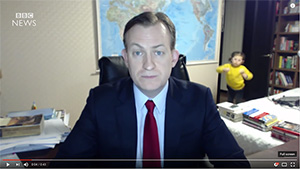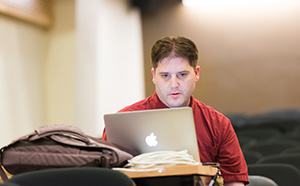8 Tips for Lecture Capture on a Shoestring
Whether you're flipping your courses, creating videos to help your students understand specific concepts or recording lectures for exam review, these tips can help you optimize your production setup on a tight budget.
- By Dian Schaffhauser
- 05/17/17
Maybe you've seen "Video Dad," the professor whose video interview on South Korean politics with the BBC was interrupted when his young daughter danced into his office, followed by a baby scooching along in a walker, followed by a harried mom trying to rescue her family from the prying eyes of the world and salvage her husband's broadcast career.

BBC commentator Robert Kelly's "Video Dad" moment
When Raul Burriel watched that video, he saw somebody with "considerable experience doing these kinds of interviews." After all, said the streaming media coordinator for Oregon State University, video dad Robert Kelly had things positioned in just the right way. The video camera is above him, pointing downward. He has positioned his own books strategically on his desk. And the space he uses is narrow, in the sense that the wall behind him is maybe four or five feet away. Burriel's guess: Notwithstanding the domestic interruption, Kelly has "probably evolved and developed this layout and look over a number of interviews."
Burriel oversees what he calls the "media ecosystem" at his university, a topic on which he speaks nationally. While Oregon State maintains media production units for creating high-quality video, these days, he noted, "everyone's got a video creation device in their pocket." In fact, he estimates that 90 percent of the video creation done on campus is user-generated content, whether it's faculty making videos to help students learn, students creating videos for assignments, webinar production or extension service tutorials made for people out in the field.

Oregon State University Streaming Media Coordinator Raul Burriel
Here's what Burriel has recommended for setting up a production studio to make videos with impact — and on a tight budget.
1) Speak Into the Microphone
When setting up a space for good video and audio recording, sound dampening is key. You want to make sure you don't get noise from people walking in the hall outside, for example, or from machines such as elevators or climate systems. While these factors can't be avoided entirely, Burriel noted, they can be addressed with insulation on the walls or a switch that opens or closes the air handling in the room.
Also, choose a quiet space to minimize ambient noise. Or as Burriel put it, "Don't choose a space where there's a basketball court upstairs."
Next, Burriel said, pay attention to your microphone. If you're creating a recording from a computer, for example, oftentimes you'll expect to use the "little pinhole" mic at the top of the PC or iMac monitor, which could be three or four feet away from where you're sitting.
Burriel's suggestion: Use a headset with a mic right by your mouth or a "boom mic" that you can have near you. Either of those options "is always better than whatever is built into your laptop or iMac," he said.
If that exceeds your capacity, then at least do these two things: "Lean in toward the mic" to direct your voice and make sure it captures your audio "to the best of its ability," and avoid "wiggling too much in your chair."
2) Reconsider Whether You Want to be a Talking Head
Lighting is a trickier topic, worth "deferring to professionals." Burriel said he's seen too many videos that come across "like some person hunched over a laptop looking to the camera recorded at two in the morning where it's really dark behind them and the only light you see is the glare of the monitor on their face."